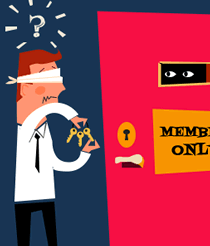In How to Make a Living in the Web Industry, I outlined a simple plan for generating enough revenue to make a living and a profit.
For round figure’s sake, I said if you needed to earn $50,000 a year and your average project is $2,000, you must land 25 projects, or roughly two jobs a month.
To land those two jobs a month, I said you must do four things consistently:
- Generate conversations with enough people in your target client base
- Separate the prospects from the suspects
- Set appointments and make sales presentations
- Close sales
One way to “generate conversations” is to cold-call. If you talk to enough people, eventually you’ll set some appointments, meet with prospects and make sales presentations. Do that enough times and eventually you’ll close a sale.
Unlike networking, which takes time, cold-calling gives you the ability to get new clients immediately. You can literally call on Monday, meet with a client on Thursday, and close the deal the week after.
But how much time and effort is involved? I don’t know about you, but I always want to compare the effort required to the likelihood of success. If I have to cold-call ten hours a day for three weeks straight, just to land a single client, I might want to rethink my strategy.
Like any marketing activity, cold-calling done wrong can produce poor results and wind up being a colossal waste of time. There’s more to it than just dialing the phone. So before you jump in, I suggest you invest in some quality training.
But assuming you can achieve at least average results, here’s a breakdown of what you might expect.
From my experience managing a telemarketing team, I know that, on average, my two best appointment setters make one sale for every 250 dials. So, using the scenario above, you must make at least 500 calls each month to land two sales.
But even the best sales people only close one in five appointments, so make sure your funnel is full by setting at least six to seven appointments—even if it means making more than 500 calls to do so.
Here’s where most cold-calling neophytes fail. As soon as they set an appointment, they get a rush of excitement and begin imagining how that appointment will turn into a sale. They might even go online, find their soon-to-be client’s website, and start preparing for the meeting.
All that’s well and good, but here’s the problem: you stopped making calls. If that one appointment doesn’t turn into a sale, and you have nothing else in the works, you’re back to square one.
Besides having a well-filled funnel, your chances of success will improve when you block off a dedicated time period to do nothing but call. You can easily make 50 calls in four hours without even trying. (That’s less than 13 an hour.) Get on a roll, and you can practically double that.
Repetition is another key component. Those new to cold-calling are afraid of “bothering” people, so they call each business just one time. But the marketing “Rule of Seven” says that a prospect needs to see or hear your message at least seven times before they’ll take action. While that’s not an absolute number, the point is that when cold-calling, it will take multiple attempts to reach a decision-maker. You’re better off calling 100 businesses five times throughout the month than calling 500 businesses one time each. The likelihood of reaching a decision-maker increases the more you call.
Cold-calling doesn’t have to be an arduous task. By breaking it into four-hour blocks, you can spread those 500 calls over 10 non-consecutive days … without even breaking a sweat.
Frequently Asked Questions about Cold Calling ROI
What is the average success rate of cold calling?
The success rate of cold calling varies widely depending on the industry, the skill of the caller, and the quality of the leads. However, on average, it’s estimated that about 1-3% of cold calls lead to an appointment or a meaningful business conversation. This means that for every 100 calls made, 1 to 3 might result in a potential business opportunity. It’s important to note that this is a rough estimate and actual results can vary.
How can I improve my cold calling ROI?
Improving your cold calling ROI involves several strategies. First, ensure you’re targeting the right audience. Research your prospects thoroughly before making the call. Second, practice your pitch. The more comfortable and confident you are, the more likely you are to make a successful connection. Third, follow up. Many sales are made on the second or third contact, not the first. Lastly, consider using a CRM or other sales software to track your calls and results.
What are some common mistakes to avoid in cold calling?
Some common mistakes in cold calling include not doing enough research on the prospect, not personalizing the call, talking too much and not listening, not having a clear call to action, and not following up. Avoiding these mistakes can significantly improve your success rate and ROI in cold calling.
How can I handle rejection in cold calling?
Rejection is a part of cold calling. It’s important to not take it personally and to use it as a learning experience. Analyze why the call was not successful and what you could do differently next time. Also, remember that every ‘no’ brings you closer to a ‘yes’.
What are some effective cold calling scripts?
Effective cold calling scripts are personalized, concise, and have a clear call to action. They should quickly establish who you are, why you’re calling, and what value you can offer to the prospect. It’s also important to ask open-ended questions to engage the prospect in a conversation.
How can I measure the success of my cold calling efforts?
There are several metrics you can use to measure the success of your cold calling efforts. These include the number of calls made, the number of appointments set, the number of sales made, and the overall ROI. Tracking these metrics over time can help you identify trends and areas for improvement.
How can I make my cold calls more engaging?
To make your cold calls more engaging, try to start a conversation rather than just delivering a pitch. Ask open-ended questions, show genuine interest in the prospect’s needs and challenges, and offer value in the form of information or solutions.
How can I overcome the fear of cold calling?
Overcoming the fear of cold calling often comes down to practice and preparation. The more prepared you are, the more confident you’ll feel. Also, remember that rejection is a part of the process and not a reflection of your worth or ability.
What is the best time to make cold calls?
The best time to make cold calls can depend on your industry and target audience. However, studies have found that the best times are generally between 8-9am and 4-5pm. It’s also generally better to call earlier in the week rather than later.
How can I follow up effectively after a cold call?
Effective follow-up after a cold call involves being persistent but not pushy. Send a follow-up email summarizing the call and offering additional value, such as relevant information or resources. If you promised to do something during the call, make sure to do it promptly. Also, don’t be afraid to make a follow-up call if you don’t hear back after a while.
Former owner and partner of web firm Jenesis Technologies, John is currently Director of Digital Strategy at Haines Local Search, a company providing local search marketing solutions to SMBs, including print and Internet Yellow Pages, web design, and local SEO. When not working or spending time with his family, John offers great sales and marketing advice on his blog, Small Business Marketing Sucks. When not working or spending time with his family, John offers great sales and marketing advice on his blog, Small Business Marketing Sucks.
Published in
·Business·Entrepreneur·Entrepreneurship·Entrepreneurship·Freelancing·Management·Marketing·Revenue·August 7, 2015


